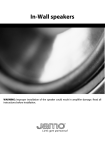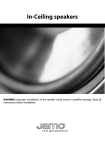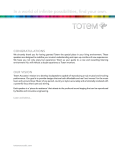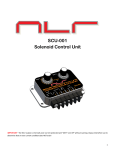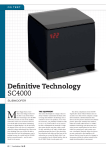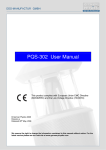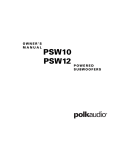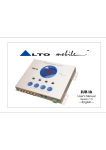Download JAMO 250 User's Manual
Transcript
Technical Description Jamo SUB 250, 300, 550, 650 General Description With this dedicated subwoofer line up from Jamo we wanted to achieve several goals. We wanted a subwoofer line up with the best ever performance per $ and we wanted it to be able to match a variety of different speaker solutions on the market, including Jamo of course. Making a dedicated subwoofer line up, instead of making designated subwoofers to a specific speaker series creates e few challenges. One challenges being to create a design and performance capable of matching basically all speakers in the marketplace. The design should be modern and “independent”, yet discreet enough to match both different speakers and different interiors. Another challenge for the development team was to optimize every “link in the chai” to achieve the best ever performance. We wanted a subwoofer line up capable of achieving high sound pressure levels (SPL) without compromising the sound quality. It is quite easy to make a subwoofer play loud – but it is a challenge at the same time to maintain precision and musicality. This turned out to require development of completely new drivers and new amplifiers as well as a new approach to manufacturing the cabinets, since it was clear very early in the development process that a new way of bass reflex loading (Slotted Bass reflex Port) had to be invented in order to keep the cabinets as compact as possible. The Products SUB 250 SUB 250 is the smallest subwoofer in the line up. But do not let this deceive you. With an long-throwing 8” subwoofer driver housed in a Slotted Bass reflex Port cabinet together with an BASH amplifier capable of delivering over 250 W peak power this subwoofer is a really strong performer capable of deliver bass down to 30 Hz (6dB). The SUB 250 has a very flat frequency response (see figure x) making it capable of playing bass notes in a very convincing way compared to many conventional bass reflex subwoofers. (see picture 1). Because of the flat frequency response all the way to 150Hz, SUB 250 is the ideal match for small satellite speakers, since it allows you to integrate it seamlessly without missing Picture 1 the important middle bass area. Many subwoofers fall of very drastically above 100Hz (or some even under, see picture 2) making them very hard to integrate with small speakers. Of course the SUB 250 is also well suited for use together with bookshelf or floorstanding speakers when there is a need for additional low frequency response. SUB 300 Picture 2 The SUB 300 is equipped with a 10” subwoofer driver and a amplifier capable of delivering 300 W of peak power. The same Slotted Bass reflex Ported construction is used here as in the SUB 250. But with more cabinet volume, allowing for deeper tuning, more power and a 10” driver this subwoofer is capable of reaching down to 28 Hz (- 6dB). Still with musical fidelity and a flat frequency response (see figure x). The level control is placed on the front of the subwoofer, elegantly integrated in the design, with a soft blue light indicating the volume setting. SUB 550 SUB 550 is the biggest subwoofer in the line up where we have incorporated the Slotted Bass reflex Port solution. With an amplifier capable of delivering over 550W peak power housed in the biggest cabinet of the series, with the deepest tuning, this subwoofer is capable of deliver ultra realistic performance at extremely high levels and still maintain the musicality of the bass notes. The SUB 550 reaches down to impressive 26Hz. Since SUB 550 reaches very low, it features a Boundary Gain Compensation switch, which further helps to keep a flat frequency response, as BGC compensates for the room influence at low frequencies. The level control is placed on the front of the subwoofer, elegantly integrated in the design, with a soft blue light indicating the volume setting. SUB 650 The SUB 650 incorporates a 12” subwoofer driver and an amplifier capable of producing 650 Watts of peak power. This subwoofer works in a closed cabinet, and even if there is no bass reflex port to contribute to a high SPL, it delivers 110 dB sound pressure level. The advantages of a closed cabinet is absolutely absence of port noise and an even better timing resulting in a musical fidelity that is even more accurate and exact than conventional ported systems. The SUB 650 is intended for high performance bookshelf and floorstanding speaker systems. The SUB 650 is capable of reaching down to 24 Hz which is why we have here incorporated the continuously variable Boundary Gain Compensation for optimum integration into the home environment. The level control is placed on the front of the subwoofer, elegantly integrated in the design, with a soft blue light indicating the volume setting. Electronics The important things on subwoofer amplifiers are the ability to deliver high power – especially peak burst are important to reproduce e.g. an explosion or a bass drum with full fidelity. This has to be done with a minimum of distortion and a very tight control of the woofer. Due to the nature of a normal class AB amplifier we would need to have a very big power supply since only approx 60% of the power is turned into sound – the rest is turned into heat. Consequently the heatsinks of these amplifiers would also have to be enormous in order to cool the amplifiers sufficiently. On the other hand a class AB amplifier has some excellent qualities – such as musicality, low distortion and high damping factor. So, if we could combine these qualities with the efficiency of a Class D amplifier it would be ideal . . . Consequently, the development team turned to a specialized technology that matched our demands perfectly: High power output with high efficiency while maintaining musicality, low distortion and tight control of the woofer. A patented technology called BASH®. The key idea of the BASH technology is based on a continually variable supply voltage which tends to zero when there is no input signal and reaches its highest level when the amplification requires power. This supply voltage is continuously variable but always lower than that of an AB class amplifier and thus a much higher efficiency is achieved. The outstanding energy efficiency (85%) achieved by this technology, allows very high output power, without heating up the amplifier and thus elimination of the need for excessive heat sinks. The power supply itself uses a high speed D class unit in order to constantly supply the amplifier with the appropriate power. Due to its voltage switching capability a BASH amplifier plays louder than a conventional amplifier of comparable RMS power. Simply by not being a voltage limited amplifier it has tremendous dynamic power capability. Controls & Features All the subwoofers features volume-, variable phase- and variable cut off frequency controls to make sure that the sound from the subwoofers can be adjusted to blend in seamlessly with the sound from the rest of the speakers. SUB 650 also features a 12V trigger input, so it can be turned on and off from a A/V receiver/controller that has a 12V output, ensuring that the subwoofer always will be active when the A/V receiver/controller is turned on. Most of today’s subwoofers have an auto on/standby feature whereby the subwoofer switches itself on if it senses a signal and switches in standby mode again a certain time after it has last sensed a signal. However, in movies (or typically classical music) with relatively quiet passages the subwoofer can switch to standby mode thereby “missing” the start of a new action packed sequence like for example an explosion or a kettledrum. Besides the auto on/standby mode we have therefore implemented a mode were the subwoofer is always on. Boundary Gain Compensation The deep frequency response of SUB 550 and 650 grants reproduction of the most extreme bass contents of e.g. movie soundtracks with full authority. However, under certain circumstances such deep frequency response can create a problem, which is why some A/V receivers/decoders feature a Boundary Gain Compensation filter. This filter compensates for the room influence at low frequencies, as any room amplifies the lowest frequencies. The magnitude of the room’s amplification depends on the actual room and where you are positioned – normally it increases the closer you get to a wall, which also means that the problem gets worse the smaller the room. This can result in too high bass level from approx. 60 Hz and increasing downwards. In the range between 20-30Hz it easily peaks up to 10dB! At first impression this could sound really impressive, but especially when listening to music the sound can be “boomy” and rather annoying. Therefore, the SUB 550 and 650 have a quite unique feature: Boundary Gain Compensation is built into the amplifiers to compensate for the room influence at low frequencies. With the usual adjustment possibilities such as cut-off frequency and volume level it will be impossible to obtain a linear in-room frequency response. However Boundary Gain Compensation will allow an additional fine tuning possibility which will compensate non optimal placement of the listening position and “difficult” acoustic properties in most rooms. Off On Off Illustration of how the Boundary Gain Compensation technology works. Note that in both off positions the peak around 20-30 Hz is much higher than 40-100 Hz, whereas in the on position the bass response is more linear. In/Outputs All the subwoofers features speaker level inputs if there is lack of a line level/LFE level output on the amplifier/receiver. All subwoofers also have both left and right line level input in case of stereo sources and a loop through capability, i.e case the signal needs to be routed through to a second subwoofer. The SUB 650 also features a 12V trigger, allowing it to be turned on automatically together with the receiver/controller if the receiver/controller has the presence of such an output. Drivers The drivers used throughout the sub series are constructed with heavy magnet systems , long VCs and very stiff paper membranes. This enables a very fast attack and a high degree of control. Sub 250 For the SUB 250 the woofer is an 8” driver with an Ø 38mm 4-layer voice coil with an X-max at +/-10mm allowing for high excursions. The heavy magnet system features a vented pole piece in order to avoid over/under pressure behind the dust cap (mechanical damping) when the cone is moving. Sub 450 & 550 For the SUB 450 & 550 a 10” driver is chosen. The driver features an Ø 38mm 4-layer voice coil with an X-max at +/-15mm allowing for high excursions. The heavy magnet system features a vented pole piece in order to avoid over/under pressure behind the dust cap (mechanical damping) when the cone is moving. Sub 650 For the SUB 650 a 12” driver is chosen . The driver features an Ø 50mm, 4-layer voice coil with an X-max at +/- 18mm allowing for high excursions. The heavy magnet system features a vented pole piece in order to avoid over/under pressure behind the dust cap (mechanical damping) when the cone is moving. Cabinets All subwoofer cabinets are made of heavy MDF board, a solid and resonance dead base for the drivers to work in. However, the Slotted Bass reflex Port is probably the most remarkable feature of the SUB 250, 450 and 550 cabinets. The slotted port is an integral part of the construction, which braces the surfaces, making the overall construction extremely rigid. The Slotted Bass reflex Port is very long allowing a low tuning frequency together with a large radiating area compared to a conventional round port, giving a high efficiency and low distortion. In normal setup, the port is radiating towards the rear wall, giving an even higher efficiency at very low frequencies. Technical Specifications SUB 250 SUB 300 SUB 550 SUB 650 Slotted Bass reflex Port 10” down firing Slotted Bass reflex Port 10” down firing Closed Cabinet Woofer Slotted Bass reflex Port 8” down firing 12” front firing Peak power [W] 250 300 550 650 Frequency range [Hz] Impedance [Ohm] 12 V trigger Phase Cut off frequency [Hz] 30-150 +3dB 22 kOhm No Yes, variable 40-150 28-150 +3dB 22 kOhm no Yes, variable 40-150 26-150 +3dB 22 kOhm no Yes, variable 40-150 24-150 +3dB 22 kOhm yes Yes, variable 40-150 Limiter Boundary Gain. Comp. Yes No yes No Yes Yes, switch yes Yes, variable 378x310x507 39 396x325x530 45 419x400x418 45 Speaker name System Outer dim. HxWxD [mm] Internal volume [l] Weight [kg] 325x266,5x468,5 30 13









